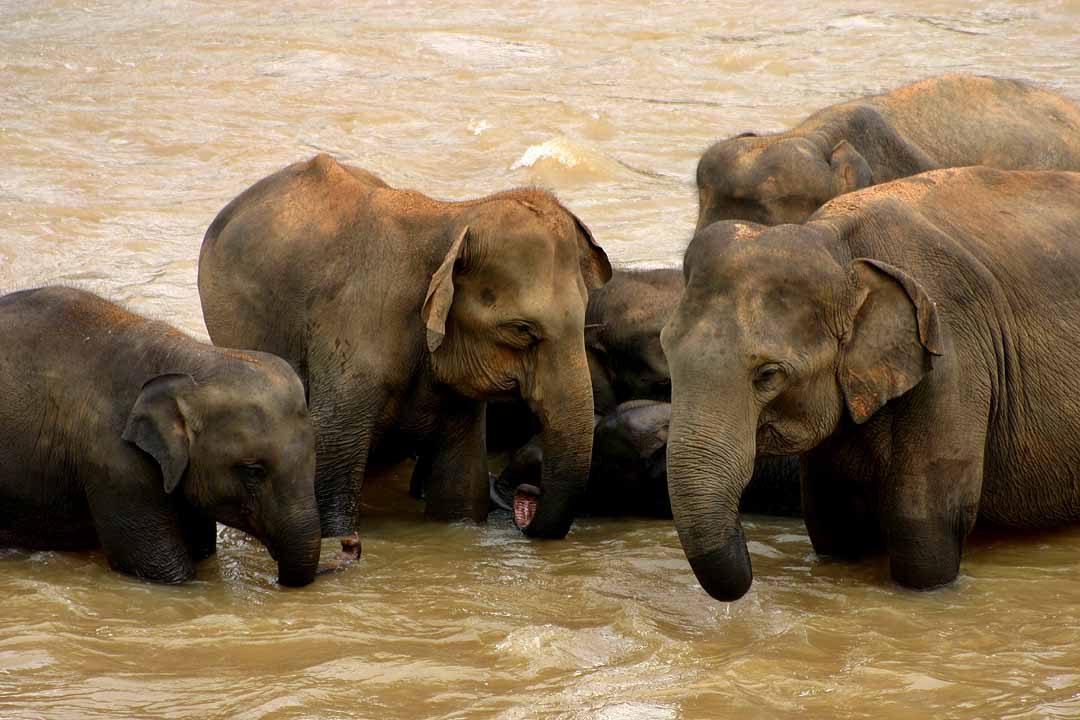- Sri Lankan Elephant
Taxobox
name = Sri Lankan Elephant

status = EN
regnum =Animal ia
phylum = Chordata
classis =Mammal ia
ordo =Proboscidea
familia =Elephantidae
genus = "Elephas "
species = "E. maximus"
subspecies = "E. m. maximus"
trinomial = "Elephas maximus maximus"
trinomial_authority = Linnaeus, 1758
range_
range_map_caption = Sri Lankan Elephant distributionThe Sri Lankan Elephant ("Elephas maximus maximus") is the nominate
subspecies of theAsian Elephant and is the largest of the subspecies although smaller than the two species ofAfrican elephant s.The
elephant population in the National Parks ofSri Lanka is somewhat diminutive in stature when compared both with historical accounts dating back to 200 BC and with the early photographs taken in 19th century during the time of colonial British occupation of the island. The smaller size could possibly be the end result of a long-continued process of removing the physically best specimens from the potential breeding-stock through hunting or domestication. Since Sri Lanka was at one time a part of peninsularIndia (there is evidence that there existed a land bridge between the northern part of the island and the subcontinent many thousand years ago), it is highly likely that the Asian Elephant, roaming South India at the time, "conquered" Sri Lanka literally on foot.An important cultural symbiosis has continued to exist between the elephant and humans for over two thousand years – no [http://www.britishcouncil.lk/kidsintouch/kandy/perahara.htm perahara] (religious procession) was complete without its retinue of elephants, and many large
Buddhist temple s in Sri Lanka had their own elephants.The Sri Lankan Elephant population is now largely restricted to a few National Parks and Nature Reserves. Udawalawe National Park, Minneriya National Park, Wilpattu National Park and Yala National Park are prime locations for spotting elephants.
Food and habitat
The Sri Lankan Elephant is an herbivore. It eats grasses, leaves, bark, fallen fruits (such as wood apple) and palm leaves (like coconut leaf).
Kitulpalm tree ("Caryota urens") is a favorite food. Large bulls need nearly 200 kg of food per day.The historical range of the Sri Lankan Elephant includes all Sri Lankan eco-regions: lowland rainforests, montane forest and the Sri Lankan dry-zone forest. Today the Sri Lankan Elephant is extinct from montane forest and occupies mainly dry-zone forests, although a small population lives in rainforests.
The Sri Lankan Elephant is endangered. Ivory trade in Sri Lanka had a very long history for more than 2000 years. In 1800s and early 1900s many bull elephants killed by trophy hunting. Between 1999-end of 2006 every year nearly 100 Wild Elephants were killed. Today few elephants live out side protected areas. Tusk elephants are very rare to see in wild due to heavy poaching. Only 5%-7% of wild elephants have tusks. Very low numbers of elephants live in Peak Wilderness sanctuary. The forest covers about 220 square km of lowland and montane rainforest. This is likely the only wild elephant population that lives in the rainforest. Historically large numbers of elephants lived in the rainforest.
Threats
The main threat is the killing of elephants to protect crops and houses. Others are poaching, deforestion, drought and starvation. During drought seasons many elephants damage agricultural land for food. Nearly 80 elephants were killed in north western Sri Lanka, 50 in south and east and another 30 in other parts of the country, totaling 160 elephant deaths in 2006 alone.
Conservation
Many national parks and nature reserves are created to conserve Sri Lankan wildlife
Main national parks and reserves that contain viable Sri Lankan elephant populations.
Pinnawala Elephant Orphanage in Kegalle treats injured elephants, caring baby elephants they lost their mothers. Nearly 70 elephants live here. Captive breeding also ongoing here.References
* Shoshani J, Eisenberg JF (1982) Elephas maximus. Mammalian Species 182: 1–8. [http://www.science.smith.edu/departments/Biology/VHAYSSEN/msi/pdf/i0076-3519-182-01-0001.pdf Full text]
Wikimedia Foundation. 2010.
